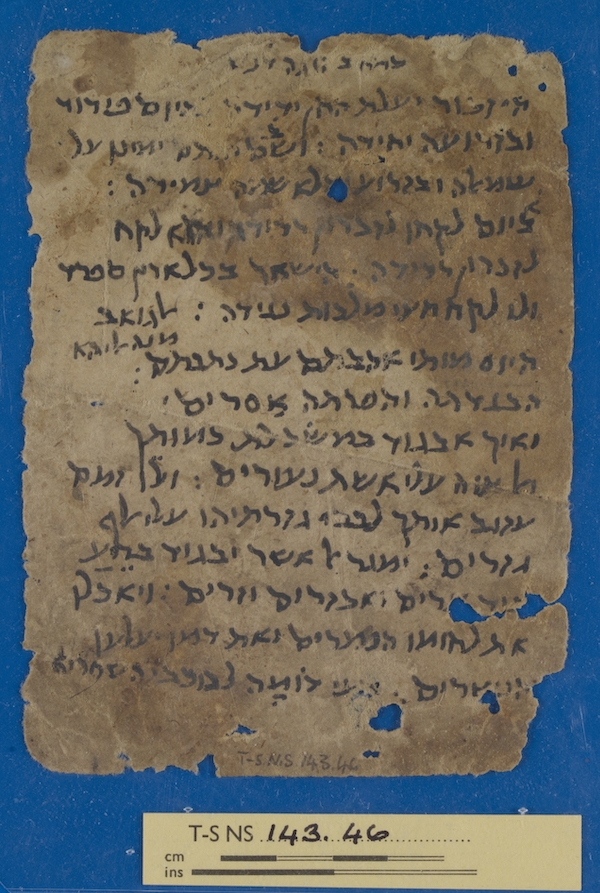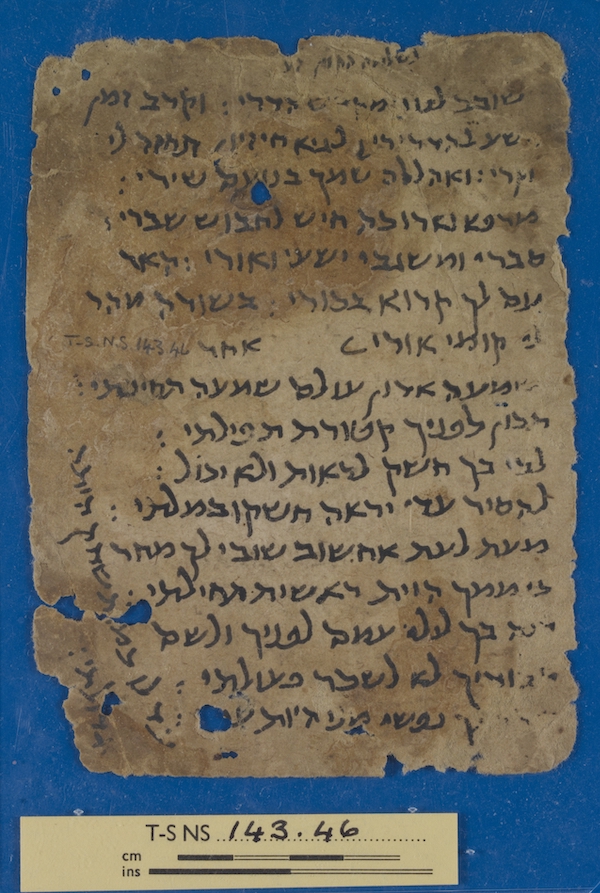A hitherto unknown poem by Shelomoh ibn Gabirol: T-S NS 143.46*
José Martínez Delgado. University of Granada

The famous poem of Mr & Mrs Dunash, T-S NS 143.46 (recto)
The document before us, TS NS 143.46, should not be headline news at this point because it famously includes the poem attributed to Dunaš b. Labraṭ’s wife. Its study began in 1944 when Allony published, from a photo, a fragment of the famous poem that he originally attributed to Ben Labraṭ.[1] Later our fragment was discovered and Fleischer showed us the identity of the author and even the reply addressed to her by her husband.[2] The discovery is unprecedented even today because previously we were only aware of two short Arabic verses by Qasmūna bint Ismāʕīl recorded in an Islamic anthology and, now, we had the first samples of Hebrew verses written by a Jewish poetess of the 10th century. Perhaps the importance of the discovery was responsible for assigning the other side of this fragment to oblivion.
TS NS 143.46 includes four poems, two on each side. Recto includes two liturgical poems, gĕʔulot, attributed to Šĕlomoh ha-qaṭan (ibn Gabirol) and both are signed with the acrostic šlmh. Verso includes two secular poems, the first is attributed to Dunaš b. Labraṭ’s wife and the second one to him. The last one seems to be incomplete and therefore this side must be the verso, the continuation lost in another folio. Three of these four poems were unknown; however, as had been said, the two secular poems have drawn widespread academic attention. Both poems have been well-studied. The two poems use the metre wāfir with all its ḥašw (stuffing feet) modified by ʕaṣb (remove the vowel beneath the fifth consonant: מַפַאעִלְתֻן → מַפַאעִלַתֻן equals מַפַאעִילֻן) which is actually very common in both Hebrew and Arabic poetry, resulting in מַפַאעִילֻן מַפַאעִילֻן פַעֻולֻן מַפַאעִילֻן מַפַאעִילֻן פַעֻולֻן in all the verses.[3] Furthermore, Lady Ben Labraṭ used the rhythm taṣrīʕ (i.e. ʕarūḍ and ḍarb share rhyme and feet in both hemistichs at the beginning of the composition) in the first two verses. She also used at the beginning of her poem the modification known as naqṣ (remove the seventh quiescent consonant and remove the vowel beneath the fifth consonant: מַפַאעִלְתֻ → מַפַאעִלַתֻן equals מַפַאעִילֻ) in the first foot of the first hemistich, being scanned this way:
הֲיִזְכּוֹר יַעֲלַת הַחֵן יְדִידָהּ בְּיוֹם פֵּירוּד וּבִזְרוֹעָהּ יְחִידָהּ
מַפַאעִילֻ מַפַאעִילֻן פַעֻולֻן מַפַאעִילֻן מַפַאעִילֻן פַעֻולֻן
הֲיִזְכֹּרְיַ עֲלַתְהַאחֵן יְדִידָהּ בְּיֹםפֵּירֻד וּבִזְרֹועָהּ יְחִידָהּ
Her husband answered her using the same meter, according to the technique known as muʕāraḍa but ending in -im; he also seems to use the rhythm taṣrīʕ from the fifth verse.

The previously unknown poem by Ibn Gabriol, T-S NS 143.46 (verso)
The other side of the fragment includes two gĕʔulot. The second composition is well-known: שִׁמְעָה אֲדוֹן עוֹלָם, and it has been included in every edition and anthology of religious poetry by Ibn Gabriol.[4] The former, to my surprise, has never been included anywhere or edited previously. The truth is that this composition shows the very characteristics of this poet: signing the acrostic šlmh, creating neologisms (such the infinitive הַדְרִיר), using rhetorical figures (for instance the partial muǧānasa in שִׁבְרִי and סִבְרִי) or syntactic alterations due to the metrics (for example, insert the verb inside the construct state chain such as in לְגֵּיְא חֶזְיוֹן תַּחֲזִיר יְקָרִי instead of the expected תַּחֲזִיר לְגֵּיְא חֶזְיוֹן יְקָרִי).
We have other readings from two of the four poems included in this fragment. These other versions confirm for us that the transmission of the texts found in TS NS 143.46 was not as good as we might expect. Clearly, the scribe has either relied on his memory thinking he was a good rhapsodist (rāwy), copied carelessly, or perhaps he held an already corrupt text. He realises himself that he is wrong when copying verses 2 and 3 from the poem by Ben Labraṭ’s wife. In any case, the other extant copies, in manuscripts and in critical editions, highlight the need for amendments which in this case can be solved thanks to metrics. The hitherto unknown poem is as follows:
1. לשלמה הקטן זׄלׄ
2. שובב לנביא מקדש הררי ׃ וקרב זמן
3. [י]שע אל הדרירי c לגיא חיזיון תחזר לי
4. יקרי ׃ ואהללה שמך בנועם שירי ׃
5. מרפא וארוכה חיש לחבוש שברי ׃
6. סברי ומשגבי ישעי ואורי ׃ האר
7. עם לך קרוא בכורי ׃ בשורה מהר
8. לי קומי אורי c
Proposed reading of the poem
שׁוֹבֵב לְנָבִיא מִקְּדָשׁ הֲרָרִי וּקְרַב זְמָן יֶשַׁע אֱלֵי הַדְרִירִי
לְגֵּיְא חֶזְיוֹן תַּחֲזִיר יְקָרִי אֲהַלְלָה שִׁמְךָ בְּנֹעַם שִׁירִי
מַרְפֵּא אֲרֻכָּה חִשׁ לְחַבֵּשׁ שִׁבְרִי סִבְרִי וּמִשְֹגַּבִּי שְׁעִי וָאוּרִי
הָאֵר פְּנֵי עַם לְךָ קְרָא בְּכוֹרִי מַהֵר בְּשֹוֹרָה לִי וְקוּמִי אוּרִי
Translation
Bring back the prophet of the Sanctuary on my Mountain
and bring the redemption time to release me
Return to the valley of the vision of my Glory
I will praise your name with the prettiness of my song
Health, heal quickly to bind up my wound
my fortress, my stronghold, look with favour and shine
Look upon your people, cry out: ‘my firstborn
bear me soon the good news and arise, shine”
Metrical analysis
Meter sarīʕ (ha-maher): מֻסְתַפְעִלֻן מֻסְתַפְעִלֻן מַפְעֻולֻן.
Mašṭūr (split) verse with ḍarb modified with kašf (remove the last consonant of watid mafrūq: מַפְעֻולַא → מַפְעֻולַאתֻ equals מַפְעֻולֻן); its ‘arūḍ is identical. This type of ḍarb accepts the modification known as ḵabn (remove the second consonant of the feet when it has no vowel: מַעֻולֻן → מַפְעֻולֻן equals פַעֻולֻן) and so it is shown as ʕarūḍ in the verses 1, 2 and 4. The rhyme is -rí with ridf (a lengthening letter before the consonant setting the rhyme).
Modifications in the stuffing feet:
ḵabn: remove the second consonant of the feet when it has no vowel (מֻתַפְעִלֻן → מֻסְתַפְעִלֻן equals מַפַאעִלֻן)
ṭayy: remove the fourth consonant of the feet when it has no vowel (מֻסְתַעִלֻן → מֻסְתַפְעִלֻן equals מֻפְתַעִלֻן).
Scansion and proposed transcription[5]
שובב לנביא מקדש הררי וקרב זמן [י]שע אל הדרירי
שׁוֹבֵב לְנָבִיא מִקְּדָשׁ הֲרָרִי וּקְרַב זְמָן יֶשַׁע אֱלֵי הַדְרִירִי
מֻסְתַפְעִלֻן מֻסְתַפְעִלֻן פַעֻולֻן מֻסְתַפְעִלֻן מֻסְתַפְעִלֻן מַפְעֻולֻן
שֹׁובֵבְלְנַֽא בִימִקְקְדָֽשׁ הֲרָֽרִי וּקְרַבזְמָֽן יֶאשַׁעאֱלֵֽי הַדְדִּירִֽי
Šubiblăná bimiqqădáš hărári uqrabzămán yašaʕʔălí hadrirí
Notes: מִקְּדָשׁ according to Exodus 15:17. הֲרָרִי Jeremiah 17:3. אֱלֵי for metrical necessity. הַדְדִּירִי neologism derived from דְּרוֹר Ezequiel 46:17.
לגיא חיזיון תחזר לי יקרי ואהללה שמך בנועם שירי
לְגֵּיְא חֶזְיוֹן תַּחֲזִיר יְקָרִי אֲהַלְלָה שִׁמְךָ בְּנֹעַם שִׁירִי
מַפַאעִלֻן מֻפְתַעִלֻן פַעֻולֻן מַפַאעִלֻן מֻסְתַפְעִלֻן מַפְעֻולֻן
לְגֵיְיְחֶֽזְ יֹןתַּחֲזִֽרְ יְקָֽארִי אֲהַֽאלְלָֽה שִׁמְךָאבְּנֹֽו עַםשִׁירִֽי
Lagiyăḥáz yuntăḥăzír yăqári ʔăhálălá šimḵabănú ʕamširí
Notes: תַּחֲזִיר for metrical necessity. I omit לי for metrical and syntactic necessity and because יְקָרִי is dependent on לְגֵּיְא חֶזְיוֹן. אֲהַלְלָה according to Psalm 69:31.
מרפא וארוכה חיש לחבוש שברי סברי ומשגבי ישעי ואורי
מַרְפֵּא אֲרֻכָּה חִישׁ לְחַבֵּשׁ שִׁבְרִי סִבְרִי וּמִשְֹגַּבִּי שְׁעִי וָאוּרִי
מֻסְתַפְעִלֻן מֻסְתַפְעִלֻן מַפְעֻולֻן מֻסְתַפְעִלֻן מֻסְתַפְעִלֻן מַפְעֻולֻן
מַרְפֵּאאֲרֻֽךְ כָּהְחִשְׁלְחַֽבְ בֵשְׁשִׁבְרִֽי סִבְרִיוּמִֽשְֹ גַּבְבִּישְׁעִֽי וָאוּרִֽי
Marpiʔărúk kaḥišlăḥáb biššíbri sibriumíš gabbišĭʕí waʔurí
Notes: אֲרֻכָּה for metrical necessity. לְחַבֵּשׁ for metrical necessity. שְׁעִי according to Genesis 4:5. שְׁעִי וָאוּרִי for metrical necessity and parallelism with the following verse; surely, the scribe copies ומשגבי ישעי according to 2Samuel 22:3 and Psalm 18:3.
האר עם לך קרוא בכורי בשורה מהר לי קומי אורי
הָאֵר פְּנֵי עַם לְךָ קְרָא בְּכוֹרִי מַהֵר בְּשֹוֹרָה לִי וְקוּמִי אוּרִי
מֻסְתַפְעִלֻן מֻסְתַפְעִלֻן פַעֻולֻן מֻסְתַפְעִלֻן מֻסְתַפְעִלֻן מַפְעֻולֻן
הָאאֵרְפְּנֵֽי עַםלָךְקְרָֽא בְּכֹֽורִי מַאהֵרְבְּשֹֽו רָהלִיוְקֻֽו מִיאֻורִֽי
Haʔirpăní ʕamlaḵqărá băḵúri mahirbăšú raliwăqú miʔurí
Notes: פְּנֵי for metrical and semantic necessity, according to Psalm 119:135 among others. קְרָא for metrical necessity. מַהֵר בְּשֹוֹרָה for metrical necessity. וְקוּמִי for metrical necessity but maybe this last hemistich lacks meter in order to introduce the biblical passage קוּמִי אוּרִי (Isaiah 60:1) as reflected in the fragment.
Footnotes
* This study was carried out under the auspices of the research project ‘The Judeo-Arabic Legacy of al-Andalus: The Linguistic Heritage’ (PGC2018-094407-B-I00)
[1] See Nehemya Allony, ‘Four Poems’, The Jewish Quarterly Review, New Series, Vol. 35, No. 1 (Jul., 1944), pp. 79-80. In fact it was the text found in Mosseri VIII.202.2 that joins together with Mosseri IV 387.2.
[2] Ezra Fleischer, ‘ʕal Dunaš ben Labraṭ wĕ-išto u-bno’, Meḥqare Yĕrušalayim bĕ-sifrut ʕiḇrit 5 (1984), pp. 189-202.
[3] For the original prosodic model used between the tenth and twelfth centuries by Andalusi Hebrew poets see José Martínez Delgado, Un manual judeo-árabe de métrica hebrea andalusí (Kitāb ʽarūḍ al-šiʽr al-ʽibrī) de la Genizah de El Cairo, Córdoba 2017.
[4] Dov Jarden, The liturgical Poetry of Rabbi Salomon ibn Gabirol, Jerusalem 1972, p. 465.
[5] For this transcription see José Martínez Delgado, “On the phonology of Hebrew in Alandalus as reflected by the adaptation of Arabic grammar and poetry”, in Juan Pedro Monferrer-Sala and Wilfred G. E. Watson (eds.), Archaism and Innovation in the Semitic Languages, Selected Papers, Córdoba 2013, pp. 73-86.
Cite this article
(2019). A hitherto unknown poem by Shelomoh ibn Gabirol: T-S NS 143.46*. [Genizah Research Unit, Fragment of the Month, October 2019]. https://doi.org/10.17863/CAM.63287
If you enjoyed this Fragment of the Month, you can find others here.
Contact us: genizah@lib.cam.ac.uk
The manuscripts in this article are included in the Cambridge Digital Library. To see these and other items visit: https://cudl.lib.cam.ac.uk/
